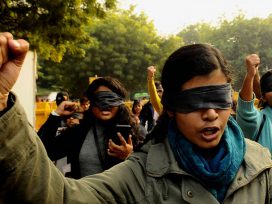Migrant women staying behind
Out of cities and work, India’s working women struggle to rebuild their lives
Millions of internal migrants were sent back to their homes across India since the first coronavirus lockdowns. By the time restrictions lifted, many women had already lost work, and faced compounding layers of inequality.
Sunita Devi’s life is a study in contrasts. On a cold February morning, the 35-year-old daily wage worker turned the wheels of a chaff cutter in her village in Uttar Pradesh, India’s most populous state. If ‘things had not changed’, Devi would have been 400 kilometers away quarrying stones instead in the neighbouring state of Rajasthan.
For more than 15 years now, Devi and her family have been inter-stiate migrants who travel to more than half a dozen cities from Mandi Mirza Khan village in search of work. Her migration, like most of India’s informal workforce, is seasonal and often circular (to earn and remit money back), lasting anywhere between six to ten months in a year. She has led a hardscrabble life of manual labour to earn just 9,000 rupees or INR (roughly 110€) a month.
But everything changed in March, 2020, when India announced a stringent nationwide pandemic lockdown, with just four hours’ notice. She was among the millions of other migrants who returned to their villages, many on foot, as the rest of the country secured themselves safely indoors.
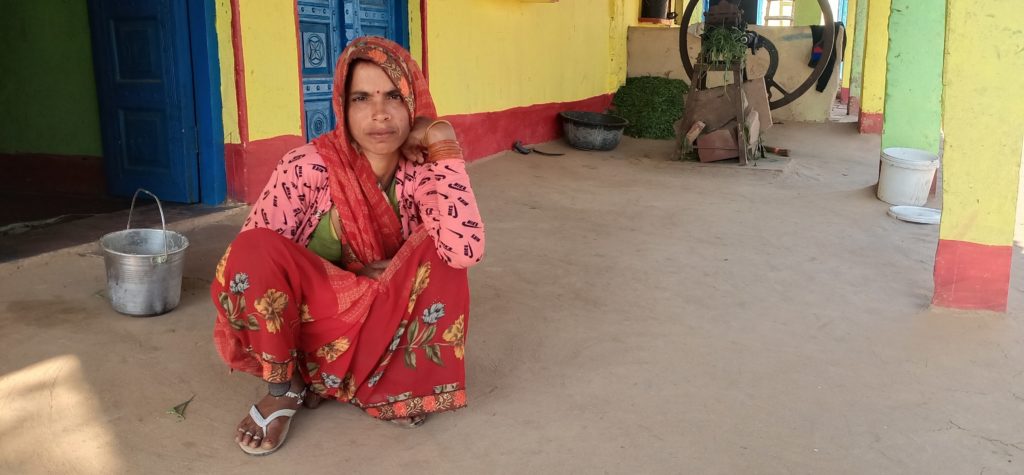
Sunita Devi, a daily wage worker, on the porch of her home in a village in India’s Uttar Pradesh. Devi has been migrating for work to other states for 15 years but has stayed behind in the village since the first pandemic lockdowns. Image by Anuja.
The experience crushed her. Two deadly waves of the pandemic and a series of smaller lockdowns by state governments followed until last year. Months of uncertainty meant that the highly mobile population of migrant workers, particularly women, were worst impacted. The period saw more women than men lose jobs.
Devi’s husband, Man Singh has returned to the migration cycle after a brief pause. She, however, decided to stay behind in the village to take care of their four children alone. Before the pandemic, her children used to travel with her each time she set out for the road. She currently has nobody to support her with childcare at home from relatives or extended family. She has had to cut down on travel and housing expenses, to safeguard her children from virus exposure, which has kept her from migrating for work. It has also shaken her confidence in how much work she would find in the cities.
‘From breaking stones to cutting grass fodder – that is how much my life changed in two years,’ she said as her husband looked on. Devi said,
I have tried finding work in the village. I took up odd jobs like labouring on other people’s farm but it pays pittance. Honestly, I am simply wasting my time and effort.
She has managed to find work for five or six days in a month, through which she earns roughly 1,200 INR (15€) monthly.
Layered vulnerability
Devi is not alone. Just across the road from her are women like Neetu (goes by one name), a construction worker who used to travel more than 1600 kilometres to the coastal city of Vijaywada in India’s southern state of Andhra Pradesh.
Guddi Devi was also a daily wage worker and earlier travelled to Rajasthan alone for work. Similar stories of distress were recounted by women from Rajasthan, West Bengal and Odisha.
These women had known no other way of earning a livelihood than migrating to look for work but now they are staying behind. They migrate because employment opportunities in the rural areas are limited to agriculture or related activities while cities offer jobs in various sectors including manufacturing, infrastructure creation and domestic work.
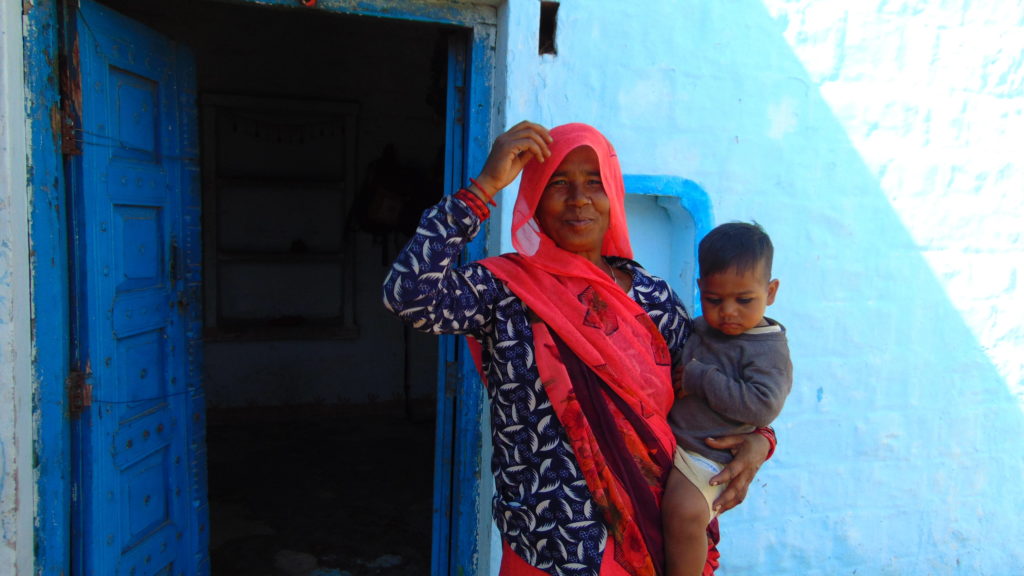
Guddi Devi at her home in a village in India’s Uttar Pradesh. Devi used to go alone to neighbouring Rajasthan in search of work but has stayed back since the summer of 2020 when the COVID-19 pandemic hit. Image by Anuja.
The inequality between Indian states or the gap between the rich and poor states is large and has increased considerably over time. The distress of these women workers doesn’t get mainstream attention in part because they are identified as associated or “marriage migrants”. Officially, marriage is the number one cause of internal migration in India, but this does not reflect many who go on to join the workforce later.
Experts like Benoy Peter, the executive director of the Indian think tank Centre for Migration and Inclusive Development (CMID), said there is a ‘layered vulnerability’ for women when they stay back to survive during a crisis:
There are a significant number of families which otherwise used to migrate before the pandemic but now remain at native places. With women especially, the staying back has impacted not just their mobility but also their autonomy.
Away from the policy spotlight, these women migrant workers are struggling to rebuild their lives in the new reality of acute financial stress, increased care work and the loss of a steady income. This is their story.
An unprecedented crisis
In the summer of 2020, more than 11.4 million workers returned home as several families covered hundreds of kilometres on foot. Such a scale of internal exodus hadn’t been seen since the disastrous times that ensued India’s partition in 1947.
Over the last two years, migrant worker families have faced wage loss, piling debt and sustained uncertainty over job recovery. A report by the International Labour Organisation in December 2020 warned that the pandemic was ‘likely to push many more millions of rural households deeper into poverty and debt traps’ in India.
More than 90% of India’s workforce is estimated to be informal or unorganised, and consists predominantly of migrant workers. They are considered key drivers of India’s economic growth.
India is estimated to be home to 600 million internal migrants, half of whom are women. Out of this, 140 million are estimated to be migrant workers.
Gender is a key distinguishing factor. More women than men among migrant workers are affected by the protracted impact of the pandemic because it has worsened pre-existing vulnerabilities like the high gender pay gap, increased care workload and gender discrimination at work. It lowered their income due to overall job losses and forced them to take up worse-paying jobs. They have coped in different ways. While some opted for short-distance and short-term migration, others decided to stay behind to cut down on expenses.
Asha Hans, director of the Development Research Institute (DRI) in Odisha’s capital, Bhubaneswar, who has extensively worked on issues of women migrant workers said that many women lost personal assets as they have had to sell or pawn whatever family gold and other valuables to make sure that the male members could keep travelling for work. Asha Hans says:
To migrate you need money. Many male workers went back immediately while several women stayed back. In some cases, migrant families back home had very small pieces of land but they could no longer employ farm labourers and so women chose to stay behind to take care of it.
Patterns of seasonal migration in India are also often linked with the agricultural cycle. Many families who predominantly work in urban constructions, prefer being back in their villages before or after the monsoon season. They don’t settle permanently in the urban spaces due to lack of resources, high cost of living, poor housing conditions or rare job opportunities.
Staying behind
While there is no official data on how many women have stayed behind, a survey published last year by Yale University tracked a group of around 5,000 migrants who returned to their home villages in 2020. A year later it found that ‘only 47% of women had re-migrated, in contrast to 55% of men’, amidst a stark gender unemployment gap.
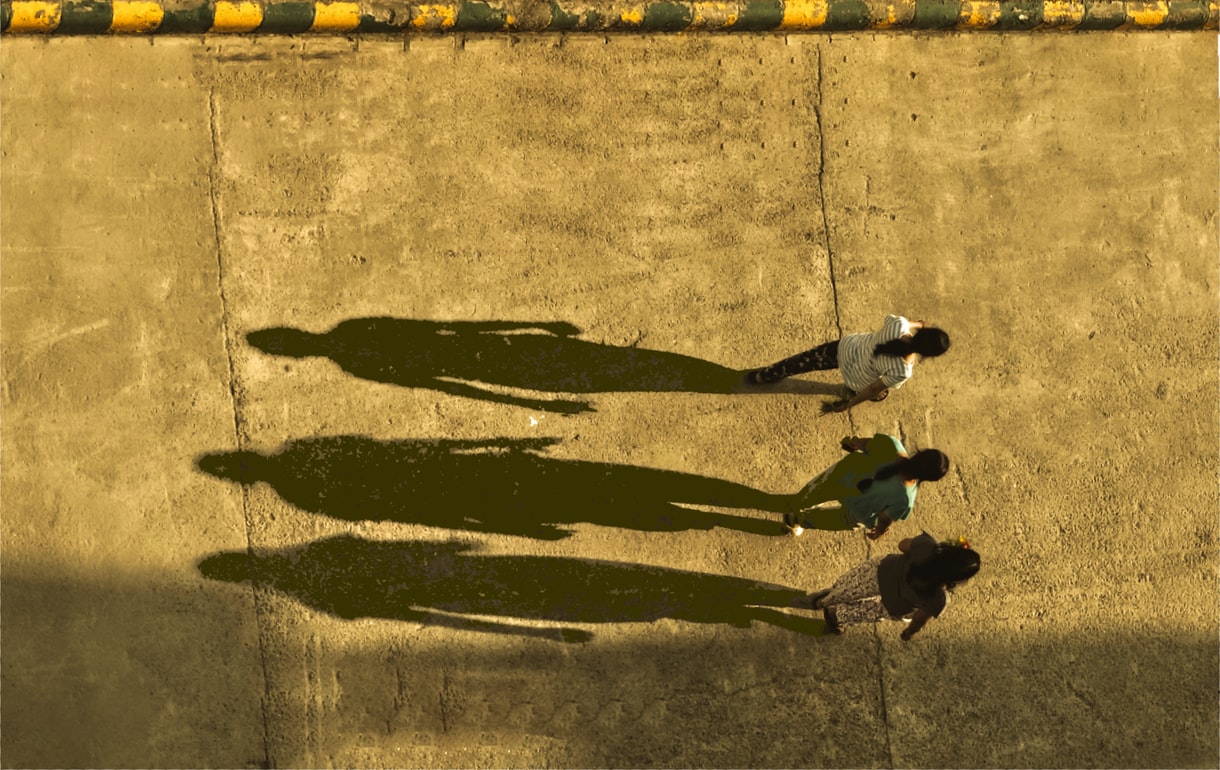
Photo by Raj Kumar from Unsplash
The crisis is grimmer in the case of single female migrants – those who travel without male family members – and have now fallen out of the workforce.
Sairul Begum, 29, lives in Dhanauli, a village on the outskirts of Agra, less than ten kilometres away from the Taj Mahal. She is a skilled embroiderer who stepped out of her state for the first time in 2018. She travelled with a group of women Rourkela, a city on Odisha famous for production of steel, taking a train journey of 26 hours and covering almost 1200 kilometres.
There, she earned a monthly income of 100€ but her travel, accommodation and living expenses were covered by the employers, which meant she could send money back home. Ever since she returned home in early 2020, her employers have not called her back, citing the lack of resources.
She said her earnings helped her contribute to the family’s expenses but since she returned, she relies entirely on her husband. Of all things that she misses, it is the financial independence the most. ‘After staying behind for such a long time, I am not sure if I will be able to go back,’ she said.
Loss of identity
Archana Roy, who teaches at the Department of Migration and Urban Studies at the Mumbai-based International Institute for Population Sciences (IIPS), said that when women migrate for work to urban areas, they have the identity of a ‘worker’:
Returning home or staying back means that their responsibility in both breadwinning and caregiving increases. Unlike men, they face an immediate loss of network, and it leads to issues like poor wage negotiation, increased working hours and higher chances of exploitation.
Migrant worker families in the informal sector often live with other related factors of precarity like lack of social security protection and access to basic services. However, issues of job loss and wage reduction have an immediate impact on their lives. In most cases, it is the only option for families to improve their lives due to lack of opportunities in their source villages.
Women and re-migration
While, the issue of re-migration of women workers is pronounced in a state like Uttar Pradesh, which has India’s highest outmigration numbers, surveys indicate that similar trends could be visible in other states too.
A 2021 study in the eastern states of Bihar and Jharkhand showed that post-pandemic, the intent to re-migrate was lower among women workers (17%) than their male counterparts (37%). It added that most women who lost their jobs dropped out of the labour force and ‘are neither looking for jobs nor thinking of migrating.’
Economist Bhaskar Chakarvorty of Warwick University was a co-author of the survey, and said its findings indicated that ‘remigration and reemployment’ of women migrant workers was a critical issue.
‘This could be widespread and be applied to large sections of rural, semi-skilled women. This might have implications of future labour market prospects as it may be difficult to bring them back to work once again,’ he said.
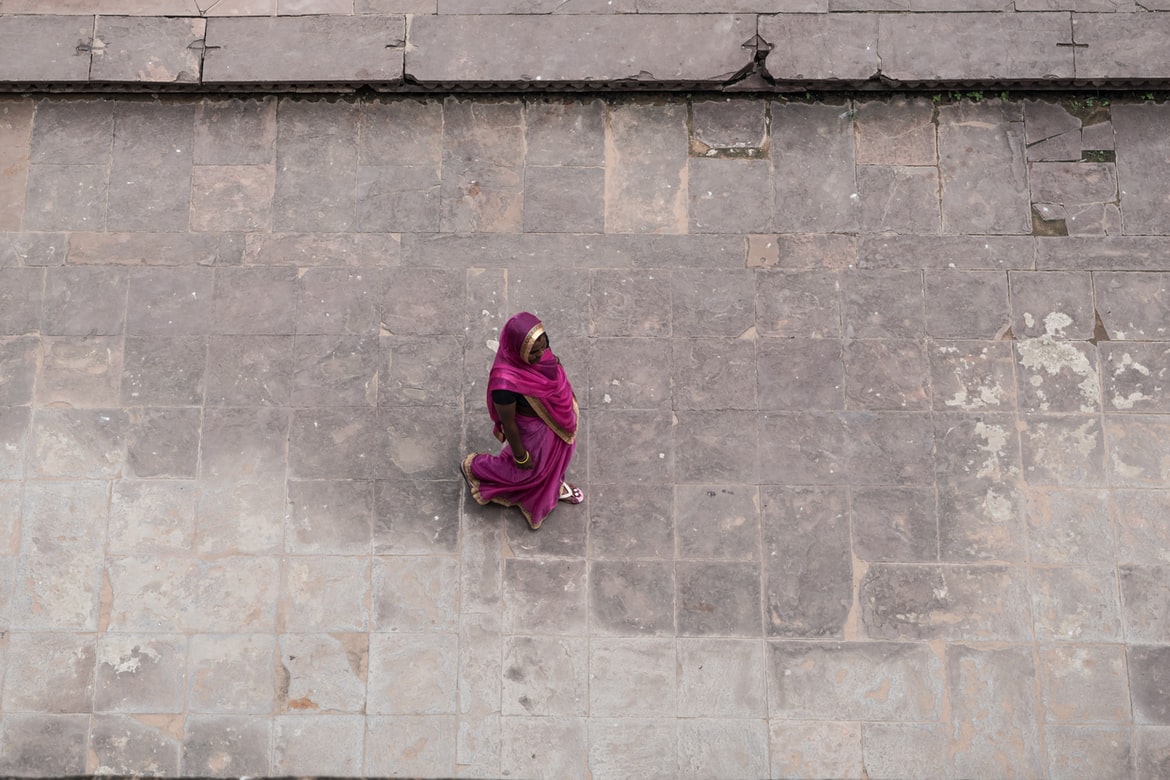
Photo by elCarito from Unsplash
Intergenerational debt
The decision for women workers to stay behind is particularly tough in cases where the family has taken loans or if they fall under the category of ‘debt-migrants’. Simply put, these are workers who agree to migrate for work in exchange of being paid an advance wage in the form of debt.
In some of the worst cases, the piling amounts lead to intergenerational debt traps forcing acute distress migration.
Purnima Barge, a 35-year-old brick kiln worker from a village near Balangir in Odisha, a state in India’s east on the Bay of Bengal, had to make a similarly difficult choice last year. For a decade now, she and her husband, Jaidhar Barge, and their three children migrated to different cities in the Southern Indian states of Andhra Pradesh and Telangana for work on advance wages that they used to pay off their debt.
Barge said over the phone to translator Dayasagar Pradhan, a safe migration activist in the region:
Recently, I have had some health issues and am unable to work well. I had no option but to stay back with my children while my husband has continued to go. There was a learning facility in the brick kiln for my children but back here I have not been able to put them in a school.
She added that her family took informal loans from an acquaintance last year to the tune of 400€. She fears that since she hasn’t found working opportunities in the village, her husband will take more than a year to repay it. She will try to re-join him for work later this year.
Policy intervention
Weeks after the migrant workers crisis of 2020, both the union and state governments sprang into action, announcing a series of steps like free foodgrain, portable ration cards, affordable rental housing and skill training, among others.
To focus its attention on job creation in rural areas, the union government in the same year launched an employment and rural public works scheme focused on boosting employment and livelihoods opportunities in six states with high out-migration rates. The Indian government’s public policy think tank NITI Ayog is also drafting a national policy on migrant workers in consultation with stakeholders including rights groups.
India also launched a national database to count and keep track of its unorganised and migrant workforce. Till the end of February, a majority of 52.7% workers registered on the portal are women, indicating the need for specific policies for their welfare. Given the protracted impact of the COVID-19 pandemic, experts say there is a growing need to have a gender sensitive migration policy with special attention towards women who have fallen out of the workforce in the last two years.
Sona Mitra, principal economist of the Initiative for What Works to Advance Women and Girls in the Economy (IWWAGE) based in New Delhi, said that focus should be on creating a robust social security net and steady employment. She emphasized:
There also needs to be proper infrastructure, particularly transport mobility, so in case there of an emergency, they can return home safely.
Long-term impact needs long-term attention
The immediate impact of the Covid-19 pandemic and its resultant movement restrictions is evident given the widespread job losses among informal workers, particularly women. While there were early signs of recovery last year, the crisis is far from over.
Most experts were unanimous in saying that in the absence of any large-scale data or surveys, it was difficult to assess what could be its long-term impacts on women migrant workers. But almost all the women migrant workers quoted above said that their issues need longer-lasting and consistent help from policy makers to recover from the impact.
Most of them, including Sunita Devi, also said that if given a chance, they would like to resume migrating again, to earn a steady livelihood for themselves and their children. But for now, she and others continue to remain cautious. ‘Not at least this year.’ she announces at the end of the conversation.
Written by Anuja and edited by Tina Lee, this article was contributed to Eurozine by Unbias the News – they published it originally on 10 March 2022. This report was produced as part of DW Akademie’s Media Fellowship on Displacement and Migration.
Published 15 July 2022
Original in English
First published by Unbias the News, published on 10 March 2022
Contributed by Unbias the News © Anuja / Unbias the News
PDF/PRINTIn collaboration with
In focal points
Newsletter
Subscribe to know what’s worth thinking about.
Related Articles

Although incoming migrants are demonized in political discourse, many European countries are struggling with a loss of population. In this episode of Standard Time, Eurozine’s colleagues talk about the idea of ethnic purity, outmigration, and finding a sense of belonging.

Hidden groundbreakers
L'Homme 1/2024
Localized political shifts have shaped Ukrainian women’s rights over the centuries: the Russian Empire once afforded property rights for aristocratic women in the south; socially active daughters of Greek-Catholic priests founded Galician societies under Habsburg rule; and forced migrants today forge new academic paths.

